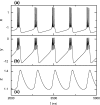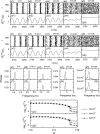Frequency-domain order parameters for the burst and spike synchronization transitions of bursting neurons
- PMID: 26157514
- PMCID: PMC4491332
- DOI: 10.1007/s11571-015-9334-4
Frequency-domain order parameters for the burst and spike synchronization transitions of bursting neurons
Abstract
We are interested in characterization of synchronization transitions of bursting neurons in the frequency domain. Instantaneous population firing rate (IPFR) [Formula: see text], which is directly obtained from the raster plot of neural spikes, is often used as a realistic collective quantity describing population activities in both the computational and the experimental neuroscience. For the case of spiking neurons, a realistic time-domain order parameter, based on [Formula: see text], was introduced in our recent work to characterize the spike synchronization transition. Unlike the case of spiking neurons, the IPFR [Formula: see text] of bursting neurons exhibits population behaviors with both the slow bursting and the fast spiking timescales. For our aim, we decompose the IPFR [Formula: see text] into the instantaneous population bursting rate [Formula: see text] (describing the bursting behavior) and the instantaneous population spike rate [Formula: see text] (describing the spiking behavior) via frequency filtering, and extend the realistic order parameter to the case of bursting neurons. Thus, we develop the frequency-domain bursting and spiking order parameters which are just the bursting and spiking "coherence factors" [Formula: see text] and [Formula: see text] of the bursting and spiking peaks in the power spectral densities of [Formula: see text] and [Formula: see text] (i.e., "signal to noise" ratio of the spectral peak height and its relative width). Through calculation of [Formula: see text] and [Formula: see text], we obtain the bursting and spiking thresholds beyond which the burst and spike synchronizations break up, respectively. Consequently, it is shown in explicit examples that the frequency-domain bursting and spiking order parameters may be usefully used for characterization of the bursting and the spiking transitions, respectively.
Keywords: Burst and spike synchronization transitions; Bursting neurons; Frequency-domain order parameters.
Figures




Similar articles
-
Noise-induced burst and spike synchronizations in an inhibitory small-world network of subthreshold bursting neurons.Cogn Neurodyn. 2015 Apr;9(2):179-200. doi: 10.1007/s11571-014-9314-0. Epub 2014 Nov 29. Cogn Neurodyn. 2015. PMID: 25834648 Free PMC article.
-
Coupling-induced population synchronization in an excitatory population of subthreshold Izhikevich neurons.Cogn Neurodyn. 2013 Dec;7(6):495-503. doi: 10.1007/s11571-013-9256-y. Epub 2013 May 8. Cogn Neurodyn. 2013. PMID: 24427222 Free PMC article.
-
Effect of spike-timing-dependent plasticity on stochastic burst synchronization in a scale-free neuronal network.Cogn Neurodyn. 2018 Jun;12(3):315-342. doi: 10.1007/s11571-017-9470-0. Epub 2018 Jan 10. Cogn Neurodyn. 2018. PMID: 29765480 Free PMC article.
-
Spiking Neural P Systems with Communication on Request.Int J Neural Syst. 2017 Dec;27(8):1750042. doi: 10.1142/S0129065717500423. Epub 2017 Aug 16. Int J Neural Syst. 2017. PMID: 28982286
-
Realistic thermodynamic and statistical-mechanical measures for neural synchronization.J Neurosci Methods. 2014 Apr 15;226:161-170. doi: 10.1016/j.jneumeth.2013.12.013. Epub 2014 Jan 30. J Neurosci Methods. 2014. PMID: 24487016
Cited by
-
From abstract topology to real thermodynamic brain activity.Cogn Neurodyn. 2017 Jun;11(3):283-292. doi: 10.1007/s11571-017-9431-7. Epub 2017 Mar 14. Cogn Neurodyn. 2017. PMID: 28559956 Free PMC article.
-
Bursting dynamics remarkably improve the performance of neural networks on liquid computing.Cogn Neurodyn. 2016 Oct;10(5):415-21. doi: 10.1007/s11571-016-9387-z. Epub 2016 Apr 28. Cogn Neurodyn. 2016. PMID: 27668020 Free PMC article.
References
-
- Bloomfield P. Fourier Analysis of Time Series: An Introduction. 2. New York: John Wiley & Sons Inc.; 2000. p. 261.
LinkOut - more resources
Full Text Sources
Other Literature Sources

